They may be small, but creating canapés is no easy feat. It takes hours or even days to create what is consumed in just seconds! Every single part of a canapé is carefully considered by the chef before it lands on your plate – and that’s the beauty of it. Despite their small size, canapés are complex and creative testaments to a chef’s skilful talent and ability to fuse colour, taste, and texture on the plate.
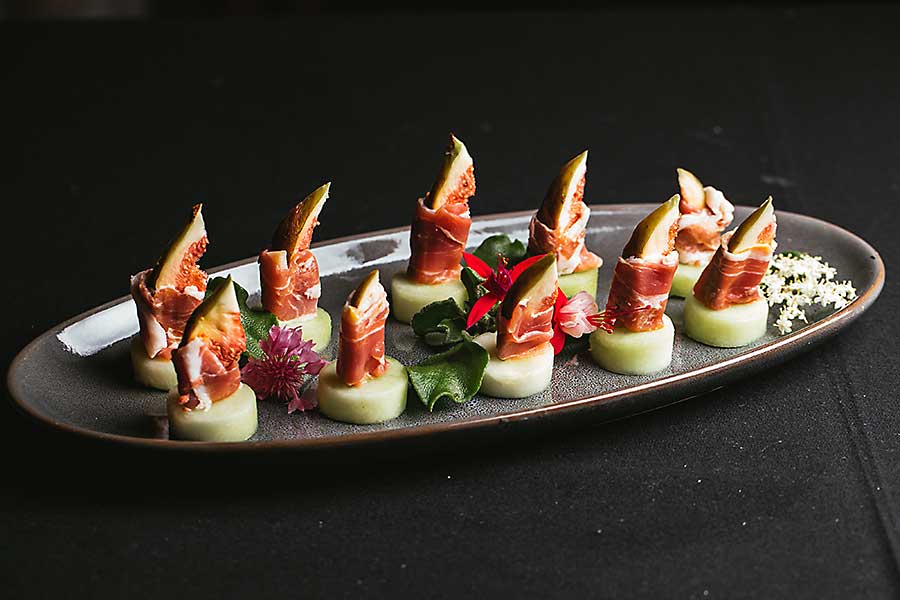
As The Independent says, “each small mouthful [of a canapé] is a chance for the chef to exhibit limitless culinary trickery”. But what’s the process behind this complex canapé creation? Here’s a behind-the-scenes look at how chefs develop the decadent morsels we call canapés.
What is a canapé?
Canapés are small pieces of food that are traditionally served before (or instead of) dinner and designed to be easy to eat. They can usually be eaten in just one or two bites, making each bit a convenient, mess-free portion. Most canapés consist of a base of bread, pastry, or can even be cracker topped with various ingredients and flavourings. You’ll often see canapés paired with cocktails, as you can eat them with one hand while you hold a drink in your other hand. That’s why they’re the perfect type of catering for a cocktail party. However, not all hors d’oeuvres are canapés—while canapés are a specific type of bite-sized appetizer, the term hors d’oeuvres refers to a broad category of small, finger-friendly foods served before a meal or at social events, and includes a wide variety of options beyond just canapés.
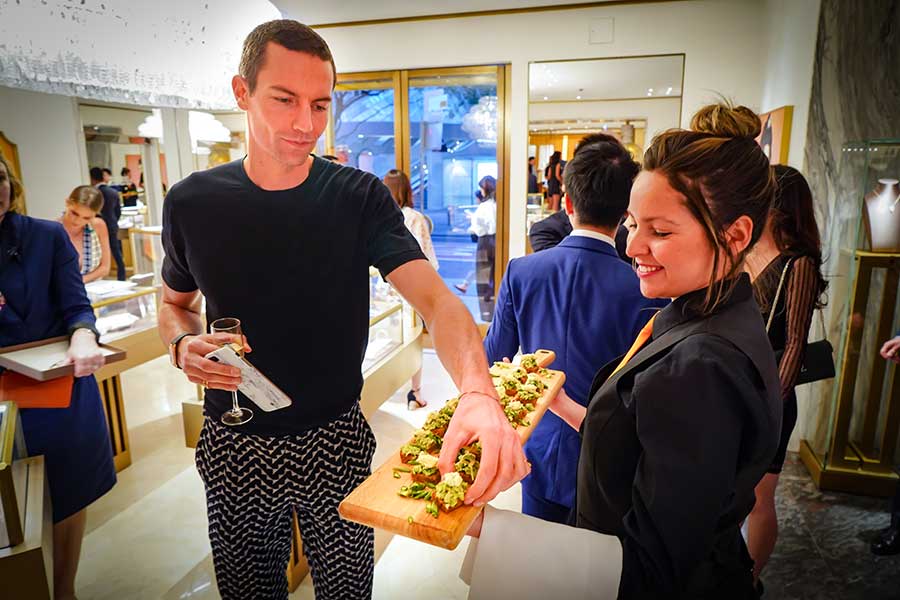
What is the history of canapés?
The word canapé comes from the French word for sofa. But we’re not talking about slouchy leather sofas you see in your living room – we’re talking about those elegant sofas you’d see in the palace Versailles, with delicate metal legs and arms and beautiful upholstery. So you can imagine the kind of elite imagery a canapé evokes.
Canapés and similar foods soon became staples at historic parties and social gatherings, where they were served as trendy hors d’oeuvres and festive treats.
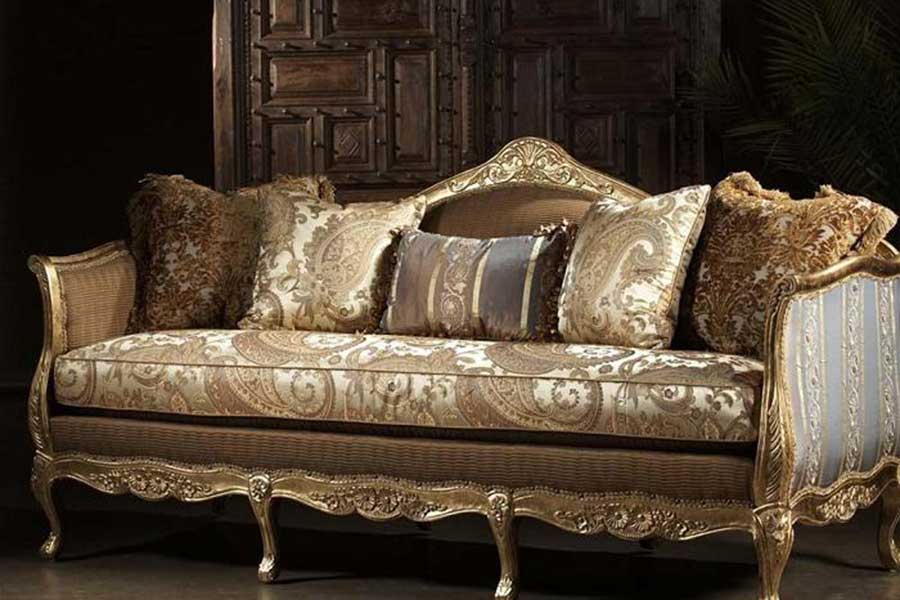
They first originated in the mid 1800s after a chef was experimenting with hors d’oeuvres and put savoury toppings on a piece of bread. Historical party foods like peek-a-boo sandwiches, which often used buttered bread slices with a peephole cut to reveal a garnished filling, also became popular during this time. So why the term canapé? The topping on the bread was like someone sitting on a sofa… oh, the obscurity of it all!
What’s the difference between canapés and hors d’oeuvres?
Many people wonder how canapés differ from hors d’oeuvres or other finger foods. That’s easy: canapés are a type of hors d’oeuvre, but not all hors d’oeuvres are canapés. Hors d’oeuvres in French means ‘outside of work’, so hors d’oeuvres in their traditional sense refer to any snack that’s served outside of the main meal. That makes canapés a type of hors d’oeuvres that consists of a base layer and a topping, which can be adjusted as desired. Sometimes people will use the terms interchangeably, but all you need to know is that they’re both a type of finger food that’s eaten while standing up.
What are the different parts of a canapé?
A canapé will always consist of a base and a topping. There can also be a sauce or a spread and a garnish.
- The base of a canapé is usually made from a small piece of bread or toast, a pastry shell, a blini, or a cracker. When making canapés, the base may be cut in half for easier eating and better presentation, and sometimes baked to achieve the desired texture.
- The spread of a canapé helps add moisture and flavour while also preventing the base from going soggy. It also helps ‘glue’ the toppings onto the bread and prevents them from slipping off. Popular spreads for canapés include butter, mayonnaise, or cream cheese.
- The topping of a canapé is the main attraction. This could be absolutely anything from a fruit or vegetable, a type of seafood, or a cut of meat. Examples of popular toppings include eggs (such as hard-boiled eggs), bacon (baked until crispy), cucumbers, fruits, mint, peppers, and pepper. Since canapés are often associated with luxury, more premium ingredients tend to be used for toppings. Picture smoked salmon, wagyu beef, prosciutto, lobster, or prawns.
- Some canapés will also have a garnish, because why not? The garnish could be anything from a sprig of herbs, caramelised onions, or caviar. A final sprinkle or sprinkling of herbs, salt, or spices can enhance both the flavour and presentation. A drizzle of olive oil or honey can also be used as a finishing touch.
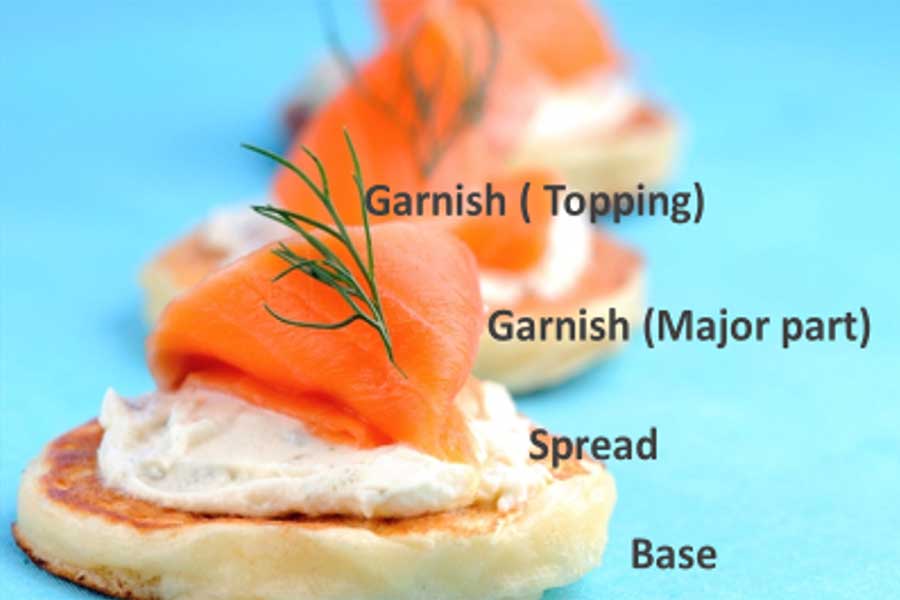
What makes a successful canapé?
Although all canapés are made from the same foundation of base, spread, topping, and garnish, that doesn’t mean they all taste or look the same. Your frozen supermarket canapés won’t be nearly the same calibre as a chef-made canapé (no offence to supermarkets). This is where being skillful makes all the difference – there are canapés that are good and there are canapés that blow people’s minds. There are two main factors that contribute to a successful canapé: the chef aims to achieve the desired balance of flavor, color, and texture, and to create a memorable taste experience.
A successful canapé may include spicy elements to make it stand out, and salt is often used to enhance the overall flavor profile.
Balancing colour, flavour, and texture
These three elements are paramount to creating canapés that are memorable and look inviting. Texture is an important one to think about – a successful canapé is one that contrasts several different textures to create an enjoyable eating experience. A canapé shouldn’t be too much of any one texture, for example too soft or too creamy or too crunchy. It should perfectly harmonise various textures for an interesting eating experience. A simple sprinkling of herbs, seeds, or spices can add both visual appeal and a burst of flavor, while a drizzle of olive oil or honey provides a final touch of shine and enhances the overall taste.
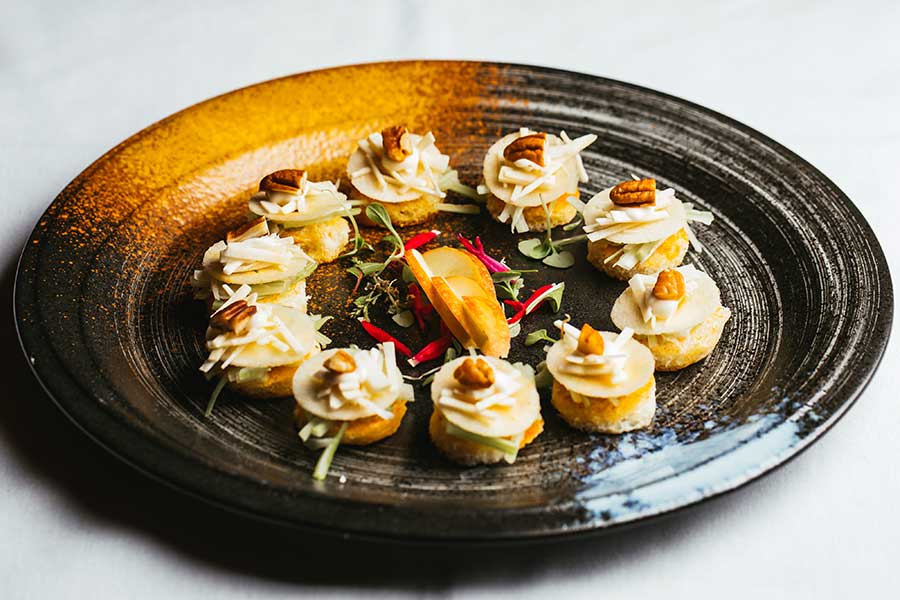
Having a variety of colours in a canapé makes it more attractive and inviting, especially if it’s presented on a buffet table for people to help themselves. Using colours in the right way can transform a canapé into a work of art. Taste, well of course! A successful canapé has to taste really good!
Ease of eating
One of the most important parts of a canapé is how easy it is to eat. Canapés are designed to be consumed with the hands, while standing up, and usually with a drink in the other hand. So a successful canapé is one that can easily be eaten with one hand and usually in one bite. Sometimes, ingredients or bases are cut in half to ensure the canapé can be eaten in a single bite and to improve presentation. If it takes more than one bite to eat the canapé, then it needs to not fall apart. A successful canapé doesn’t leave sauce on the hands and isn’t messy to eat. It should be swiftly consumed in one or two bites and that’s the end of that…
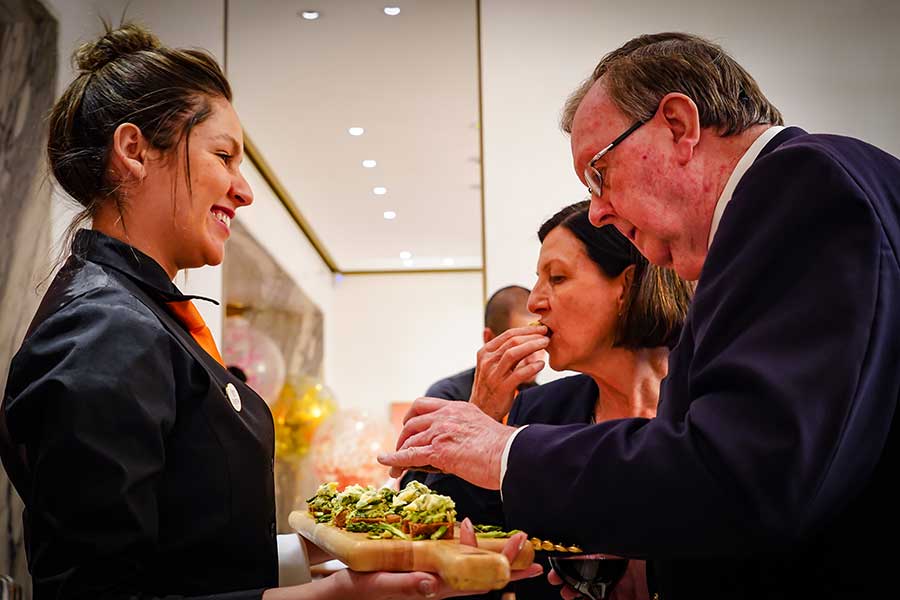
What are typical canapé garnish ingredients?
Adding garnish to a canapé can really give it an extra wow factor. They add a decorative touch but also a hint of extra flavour, whether that’s heat or brininess or sweetness. Here are some different garnishes used on canapés:
- Shaved truffles,
- Cornichons,
- Caviar,
- Capers,
- Chopped olives,
- Lemon zest,
- Caramelised onion,
- Chopped herbs,
- Mint,
- Pepper,
- Peppers,
- Crushed nuts,
- Microgreens,
- Sliced cherry tomatoes.
A sprinkle or sprinkling of salt or spices can also be used as a finishing touch to enhance both the taste and presentation of your canapés.
What are some different types of canapés?
So, what can you expect when you order canapés? These are some examples of popular canapés to give you an idea of the different types of canapés a chef might make:
- Porcini, shiitake, and cremini mushrooms with Gruyere cheese on a base of polenta topped with minced thyme,
- Caramelised asparagus and shallots with cream cheese on a base of crispy toast topped with toasted walnuts and lemon zest,
- Smoked salmon with horseradish cream cheese on sliced cucumber topped with chopped fresh chives,
- Black olive tapenade and fresh crumbled goat cheese on a crispy base topped with fresh thyme leaves,
- Sliced peach and prosciutto and lemon-shallot mascarpone cream cheese on a sliced baguette topped with fresh chopped basil,
- Fresh cranberries, ginger, coriander, and jalapeños with goat cheese on crunchy toast topped with roasted pumpkin seeds,
- Cracker topped with whipped feta, roasted red peppers, and a drizzle of extra virgin olive oil,
- Mini baked canapés with bacon, eggs, and chives on a pastry base,
- Sliced cucumbers with herbed cream cheese, mint, and smoked salmon,
- Fresh fruits such as strawberries or figs with goat cheese and a drizzle of honey,
- Canapés featuring roasted peppers, eggs, and crispy bacon for a savory bit,
- Bite-sized canapés with mint, cucumbers, and fruits for a refreshing option.
Some canapés are finished with a drizzle of olive oil or honey for extra flavor and visual appeal. Certain canapés are baked to achieve the desired texture and crispiness, especially those with bacon or cheese. Each canapé is designed to be a small bit, easy to eat in one bite, and ingredient choices can be adjusted as desired to suit different tastes. For presentation, canapés are often arranged on a tray for elegant and convenient serving at gatherings.
Now that we know what makes up a canapé, here’s a behind-the-scenes look at how chefs design and make them, from concept to creation.
Step 1: Creative brainstorming
The seed for every canapé a chef creates starts with the client or event. The process of making canapés begins with understanding the desired outcome for the event, especially when these canapés are intended for parties or social gatherings. The client’s ideas or needs, their budget, the guests, the type of celebration, theme, and venue are all taken into account. Knowing where the canapé will be eaten plants the seed for a chef who will then get busy brainstorming a creative menu that’s indulgent, instagrammable, and bound to impress the guest list.
This brief coming from the client will form the base of a chef’s canapé recipe. They’ll take the initial ideas and merge them with the culinary trickery and techniques they’ve picked up throughout their career. Every chef has a different skill set, is versed in different cuisines, and brings their own set of artistry to the table. So canapés will always reflect the chef.
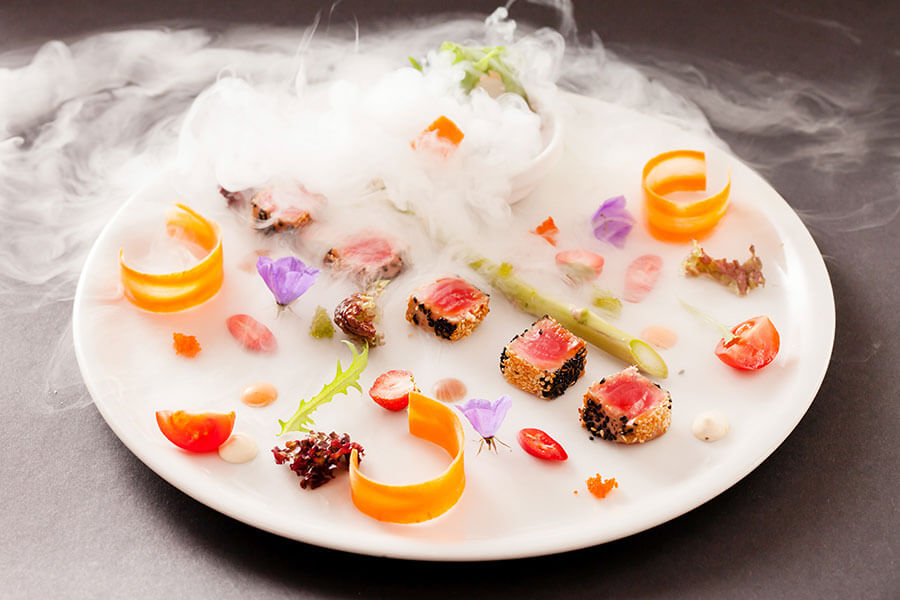
Food doesn’t just fall onto the plate like this naturally. It takes meticulous design, consideration, and effort.
Step 2: Sourcing fresh, gourmet ingredients
Flavour doesn’t just come from a combination of spices and seasoning. The best flavour comes from within, and most chefs will go straight to the source when shopping for their canapé ingredients. The secret sauce to any mouth-watering dish is the freshness of ingredients used, and most chefs look for produce that has reached peak flavour and maturity. Chefs often seek out fresh ingredients such as fruits, mint, cucumbers, peppers, and eggs, selecting each based on the desired flavor and quality.
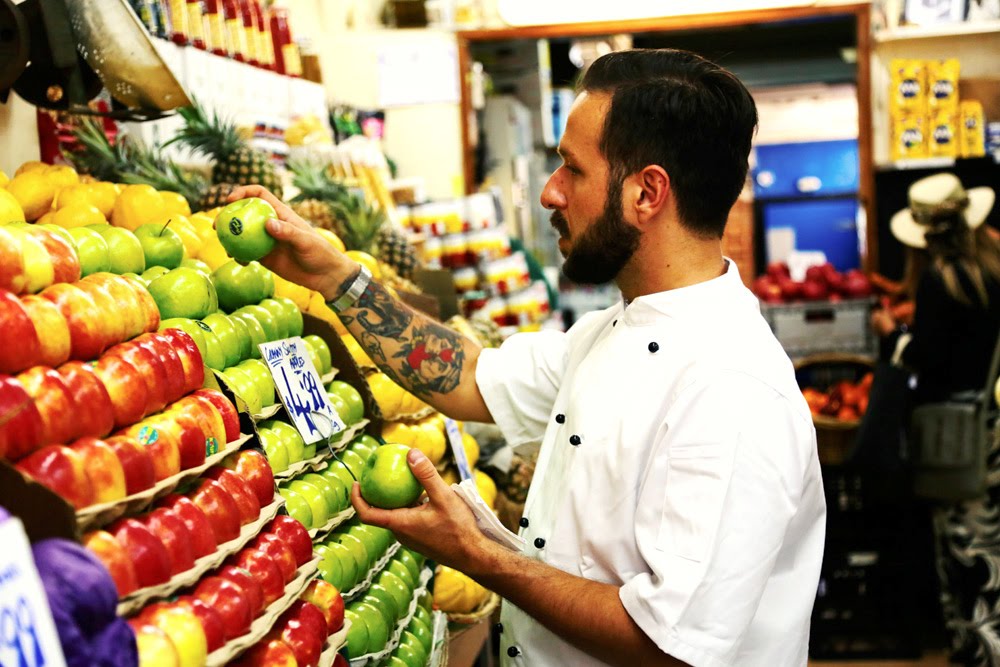
Farmers’ markets, fish markets, delicatessens, bakeries… it’s funny how shopping for something so small can take hours, or days of attention.
Shopping for canapés isn’t as simple as checking the list and grabbing the number of vegetables needed. It’s a laborious task of inspecting each and every item, smelling it, feeling it, and getting a good sense of ripeness before putting it in the basket. You’d better bet that a chef’s inventive recipe is not going to be wasted on a less-than-incredible vegetable or seafood.
The time chefs spend in markets doesn’t just involve picking ingredients and assessing their quality. There’s a lot of effort that goes into building relationships with store owners. Having a good rapport with the staff at a fish market means the chef will get the freshest and best salmon of the day. If the chef knows the farmer well, they’ll save them the ripest pick of the bunch each time.
Chefs put an enormous amount of work into getting to know their producers and building relationships to ensure the customer ends up with premium ingredients and delicious canapés.
Step 3: Slicing, dicing, and prepping
Canapés are complex. The number of ingredients and the amount of preparation that can go into making canapés—each a perfect, small bit designed for one bite—is astounding. That dollop of sauce? It could have taken hours to cook. There’s making the broth for the sauce, chopping the ingredients, boiling it down, thickening it, refrigerating it… and then each canapé may end up with only a few drops. Extremely flavoursome drops, but still.

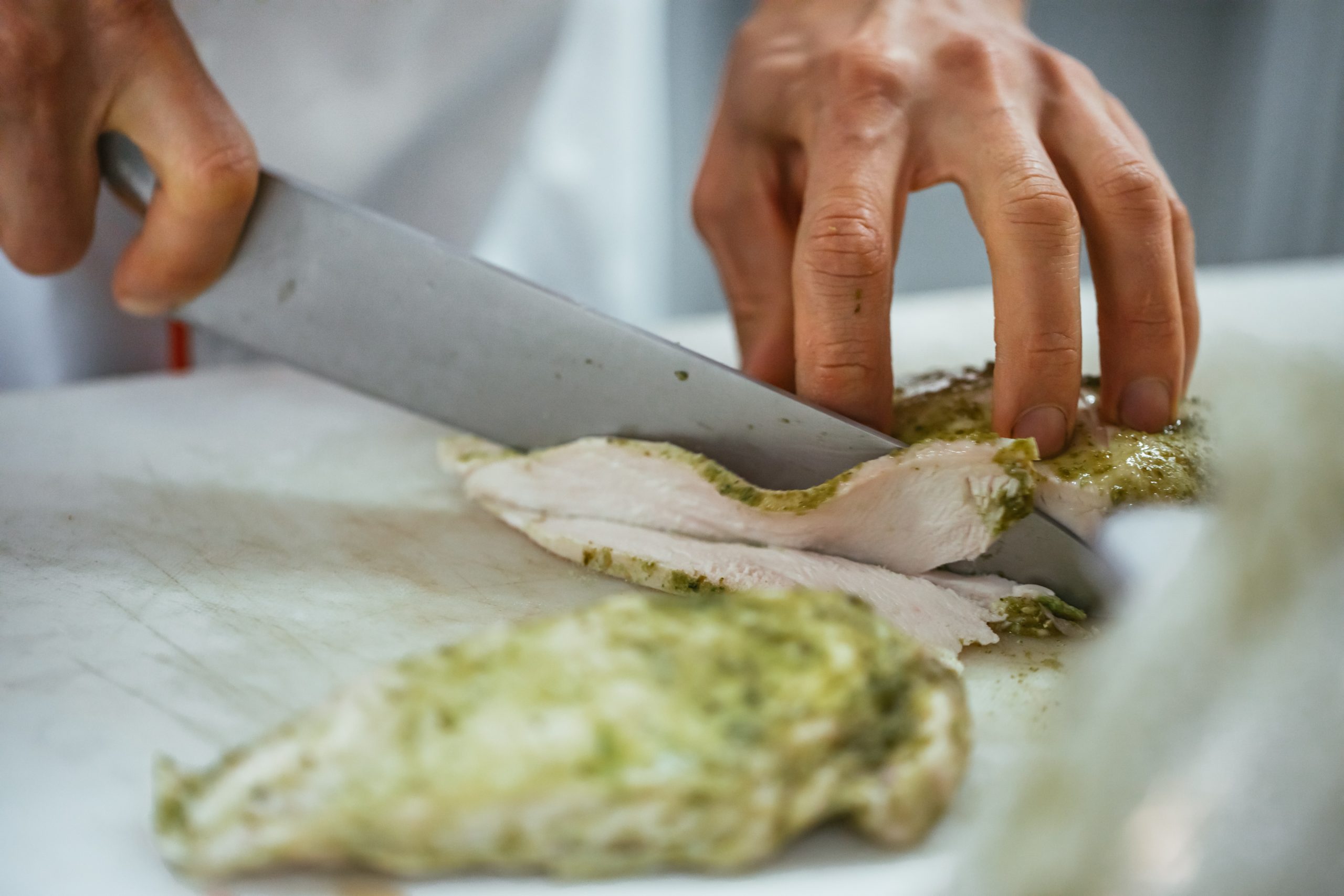
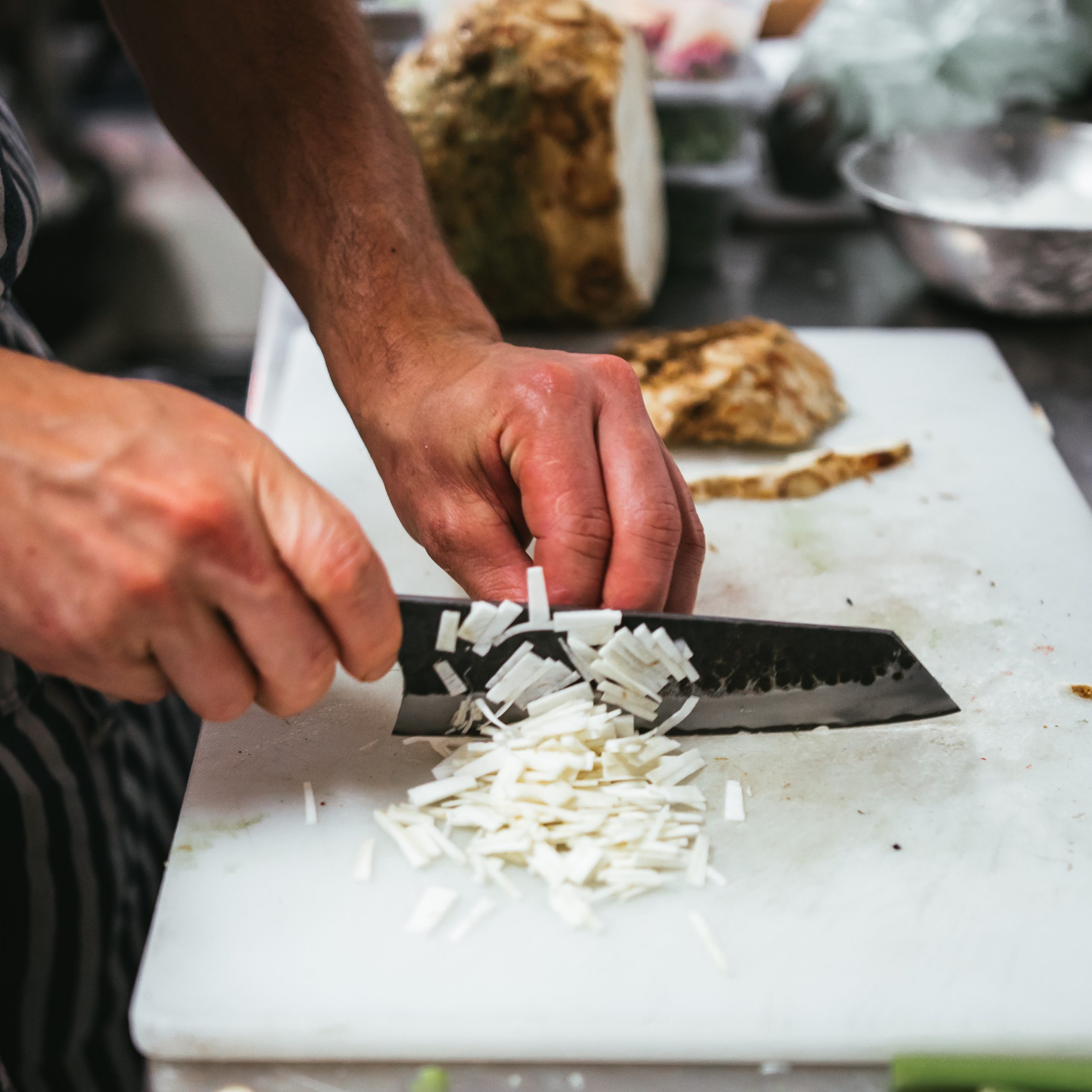
Every ingredient in the tiny flavour bombs that are premium canapés requires precise chopping, slicing, dicing and prepping. Often, ingredients are cut in half to ensure neatness and make them easy to eat in one bit. Some components are baked to achieve the perfect texture, while others are roasted or fried. Some are steamed while others are experimented with and turned into foam. Some require freezing, others require toasting. Some are glazed, others are reduced.
Canapé creation is all about balancing the unique needs and aspects of every delicate ingredient and bringing them together seamlessly. It’s no easy feat. Next time you pop a canapé in your mouth, stop for a moment and appreciate all the effort that has gone into making canapés and that end product. Relish it.
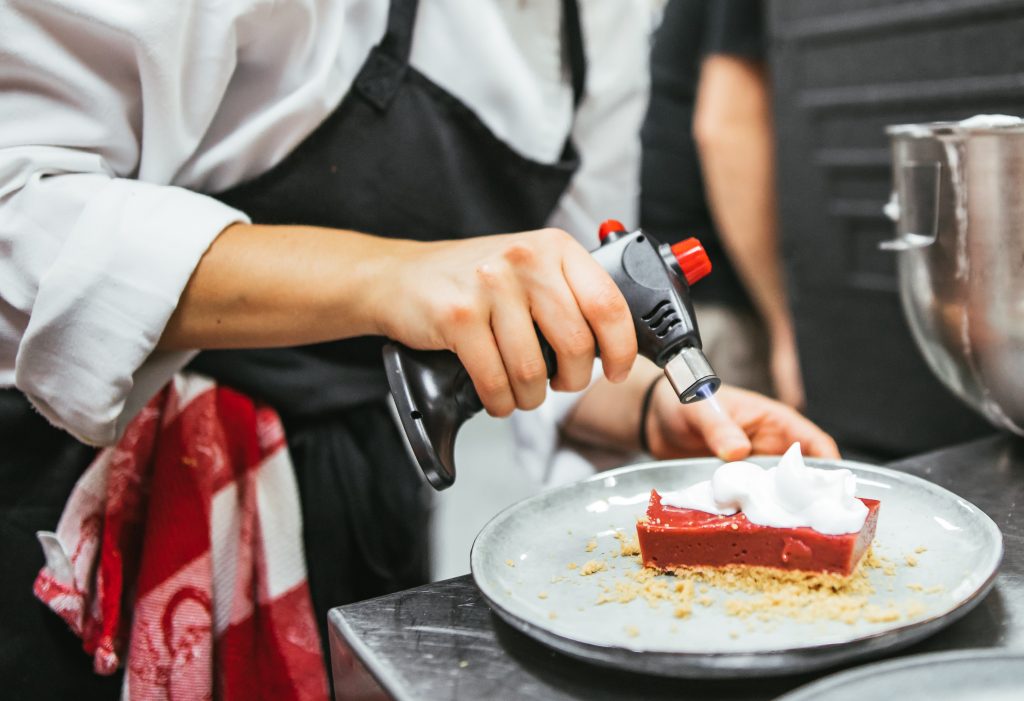
Step 4: Plating up
The plating up process is the part that people love to watch the most. Why? Because plating up is a true art and an absolute joy to witness.
It’s the final coming-together of all the exquisite ingredients and elements of the canapé. Plating up is all about precision, structure, focus, and meticulous design. This is where a chef can truly showcase their mastery in their craft, presenting their dishes with real aesthetic while also sticking to the easy-to-eat finger food rule of premium canapés.
A finishing touch often includes a sprinkle or sprinkling of fresh herbs, spices, or seeds, and a drizzle of extra virgin olive oil or honey to enhance both flavor and appearance. Once completed, canapés are typically arranged on a tray for elegant presentation and easy serving at gatherings.

Thin slices can be wrapped or overlapped to create a pattern. Moulds are used to help sauces, creams, and purees retain texture and shape. Plating up is all about creating composition, a sense of elegance and intrigue, and making premium canapés that are extremely Instagrammable.
Serving Canapés: Timing, Temperature, and Technique
Serving canapés is an art in itself, and getting the timing, temperature, and technique just right can elevate your event from ordinary to unforgettable. Whether you’re hosting a lively cocktail party or an elegant sit down dinner, planning when and how to serve your canapés is key to keeping guests happy and engaged.
For a cocktail party, aim to serve 4 to 6 canapés per person during the first hour—this helps encourage guests to mingle and enjoy the food as soon as they arrive. As the party continues, 2 to 4 canapés per person per hour will keep everyone satisfied without overwhelming them. If you’re planning a sit down dinner, a selection of 2 to 3 canapés per guest is usually the perfect way to start the evening and whet the appetite.
Temperature plays a big role in the enjoyment of canapés. Some, like smoked salmon on a thin slice of bread or cucumber, are best served cold to highlight their fresh, delicate flavors. Others, such as puff pastry bites filled with cheese or vegetables, are most delicious when served hot straight from the oven. To add a burst of flavor, try drizzling your canapés with a touch of olive oil, a squeeze of lemon juice, or even a hint of honey for a sweet finish.
Presentation matters, too. Arrange your canapés on trays or a buffet table, using a variety of colorful vegetables, herbs, and meats to create an enticing display. For guests with dietary needs, offer gluten free options like rice crackers or gluten free bread, so everyone can enjoy these delicious finger foods. The key is to make each canapé easy to eat in one or two bites, with a balance of flavors and textures that will keep your guests coming back for more.
By paying attention to these details, home cooks can serve canapés that are not only visually stunning but also bursting with flavor—making every guest feel welcome and every event a little more special.
Private Chefs, Art of Dining
CHEFIN is a private chef platform that’s reimagining social dining.
You can easily connect with 1 of our 250 private chefs and treat your guests to restaurant-quality dining experiences in the comfort of your own home, office or chosen venue. From high-end dining to quirky social food experiences, the CHEFIN platform makes it effortless for you to access gourmet food that’s worthy of a Michelin-starred establishment.
What you get:
- Your very own private chef who is vetted and insured,
- A customised menu for your needs,
- 24/7 concierge support,
- Complete post-dinner cleanup,
- A fun, stress-free, and unforgettably dining experience!


Explore CHEFIN Canapes package
Conclusion: The Lasting Impression of a Perfect Canapé
A perfectly crafted canapé is more than just a small bite—it’s a memorable experience that can set the tone for your entire event. Whether you’re hosting a cocktail party, a sit down dinner, or a festive buffet, canapés have the power to delight your guests and leave a lasting impression.
The secret lies in using high-quality ingredients and thoughtful combinations. Imagine the creamy richness of ricotta cheese or cream cheese paired with the smoky flavor of salmon, the freshness of chopped chives, or the briny pop of olives. A thin layer of butter or a flavorful spread adds moisture and depth, while toppings like thin slices of meat or vibrant vegetables bring color and excitement to every bite.
Presentation and timing are just as important as flavor. Serve your canapés at the right temperature—hot from the oven or refreshingly cold—and arrange them beautifully to catch your guests’ eyes. Whether you’re a seasoned entertainer or a home cook trying canapés for the first time, these small bites are a wonderful way to add elegance and sophistication to any gathering.
With a little creativity and attention to detail, you can create canapés that are as delicious as they are beautiful. So why not experiment with different spreads, cheeses, and toppings at your next event? Your guests will appreciate the effort, and you’ll enjoy the satisfaction of serving food that’s both impressive and irresistible. A perfect canapé is more than just an appetizer—it’s a conversation starter, a flavor adventure, and a lasting memory for everyone at your table.